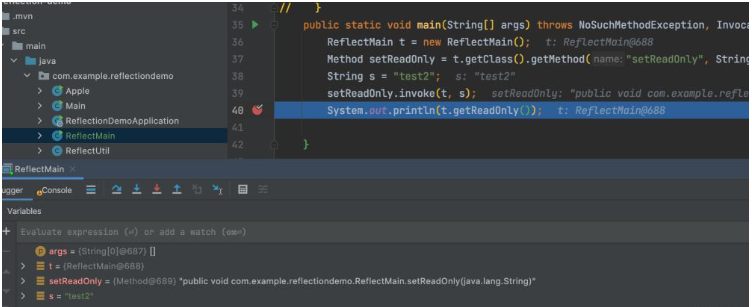本文小编为大家详细介绍“java怎么使用反射给对象属性赋值”,内容详细,步骤清晰,细节处理妥当,希望这篇“java怎么使用反射给对象属性赋值”文章能帮助大家解决疑惑,下面跟着小编的思路慢慢深入,一起来学习新知识吧。
前言
最近项目中遇到一个问题,就是能实现一个类将以后的多语都进行转换的通用方法,根据这个需求,决定使用反射实现,根据反射给对象属性设置属性值,下面是使用反射实现对对象属性值进行设置的方法
方法1:这里使用了Field的set方的 Field 属性,然后设置可见性,然后设置了一个值,最后打印
// 给变量赋值 给object对象的某个字段赋值
f.set(object, value);
//拿到了Field类的实例后就可以调用其中的方法了
//方法:get(Object obj) 返回指定对象obj上此 Field 表示的字段的值
package com.example.reflectiondemo; import java.lang.reflect.Field; public class ReflectMain { private String readOnly; public String getReadOnly() { return readOnly; } public void setReadOnly(String readOnly) { System.out.println("set"); this.readOnly = readOnly; } public static void main(String[] args) throws NoSuchFieldException, IllegalAccessException { ReflectMain t = new ReflectMain(); Field f = t.getClass().getDeclaredField("readOnly"); f.setAccessible(true); f.set(t, "test"); System.out.println(t.getReadOnly()); }}方法2:使用invoke方法
package com.example.reflectiondemo; import java.lang.reflect.Field;import java.lang.reflect.InvocationTargetException;import java.lang.reflect.Method; public class ReflectMain { private String readOnly; public String getReadOnly() { return readOnly; } public void setReadOnly(String readOnly) { System.out.println("set"); this.readOnly = readOnly; } // public static void main(String[] args) throws NoSuchFieldException, IllegalAccessException {// ReflectMain t = new ReflectMain();// Field f = t.getClass().getDeclaredField("readOnly");// f.setAccessible(true);// f.set(t, "test");// System.out.println(t.getReadOnly());//// } public static void main(String[] args) throws NoSuchMethodException, InvocationTargetException, IllegalAccessException { ReflectMain t = new ReflectMain(); Method setReadOnly = t.getClass().getMethod("setReadOnly", String.class); String s = "test2"; setReadOnly.invoke(t, s); System.out.println(t.getReadOnly()); }}
由此可见,使用反射我们能给很容易的给各个属性进行设置,即使是private的属性我们也能很轻松的设置属性值,下面利用这个demo例子,就设置了我们的最初的功能。
总结:
也就是说,第一种方法,没有调用属性的set方法就完成了赋值,
但是第二种方法,是通过调用属性的set方法来完成赋值。
所以,如果想在程序中改变程序的属性的值的同时还想做一些额外的事情,可以将这些事情写到set方法中并使用第二种方法
public class MultiLangContentUtil { public static void setMultiLangDTOName(Object targetPO, Object targetDTO, String targetMultiName) { try { String locale = MultiLangContentUtil.getLocale(); Class<?> targetDTOClass = targetDTO.getClass(); Class<?> targetPOClass = targetPO.getClass(); //这里是将targetMultiName进行展示 Field declaredFieldDTO = targetDTOClass.getDeclaredField(targetMultiName); declaredFieldDTO.setAccessible(true); switch (locale) { case ZH_CN: //获取PO的值 Field declaredFieldPO = targetPOClass.getDeclaredField(targetMultiName); //获取DTO对象 declaredFieldPO.setAccessible(true); //对DTO根据PO进行设置 declaredFieldDTO.set(targetDTO, declaredFieldPO.get(targetPO)); break; case EN_US: //获取PO的值 Field declaredFieldPO2 = targetPOClass.getDeclaredField(targetMultiName + 2); //获取DTO对象 declaredFieldPO2.setAccessible(true); //对DTO根据PO进行设置 declaredFieldDTO.set(targetDTO, declaredFieldPO2.get(targetPO)); break; case ZH_TW: //获取PO的值 Field declaredFieldPO3 = targetPOClass.getDeclaredField(targetMultiName + 3); //获取DTO对象 declaredFieldPO3.setAccessible(true); //对DTO根据PO进行设置 declaredFieldDTO.set(targetDTO, declaredFieldPO3.get(targetPO)); break; default: break; } //防止没有抽取多语的情况下没有参照返回,默认情况下设置中文 if (StringUtils.isBlank((String) declaredFieldDTO.get(targetDTO))) { //获取PO的值 Field declaredFieldPO = targetPOClass.getDeclaredField(targetMultiName); //获取DTO对象 declaredFieldPO.setAccessible(true); //对DTO根据PO进行设置 declaredFieldDTO.set(targetDTO, declaredFieldPO.get(targetPO)); } } catch (NoSuchFieldException e) { log.error("查询当前字段--->{}不存在{},", targetMultiName, e); } catch (IllegalAccessException e) { log.error("查询字段--->{}多语时发生非法状态异常{},", targetMultiName, e); } catch (Exception e) { log.error("查询字段{}多语时发生错误{},", targetMultiName, e); } catch (Throwable throwable) { log.error("查询多语言字段{}发生未知错误{}", targetMultiName, ThrowableUtil.stackTraceToString(throwable)); } } public static void updateMultiLang(Object targetDTO, Object targetPO, String fieldName, Integer MultiLangSize) { try { Class<?> targetDTOClass = targetDTO.getClass(); Class<?> targetPOClass = targetPO.getClass(); Field dtoClassField = targetDTOClass.getDeclaredField(fieldName); dtoClassField.setAccessible(true); if (StringUtils.isNotBlank((String) dtoClassField.get(targetDTO))) { Field poClassField = targetPOClass.getDeclaredField(fieldName); poClassField.setAccessible(true); poClassField.set(targetPO, dtoClassField.get(targetDTO)); } for (int i = 2; i <= MultiLangSize; i++) { Field dtoClassField2 = targetDTOClass.getDeclaredField(fieldName + i); dtoClassField2.setAccessible(true); if (StringUtils.isNotBlank((String) dtoClassField2.get(targetDTO))) { Field poClassField2 = targetPOClass.getDeclaredField(fieldName + i); poClassField2.setAccessible(true); poClassField2.set(targetPO, dtoClassField2.get(targetDTO)); } } } catch (NoSuchFieldException e) { log.error("更新当前字段--->{}不存在{},", fieldName, e); } catch (IllegalAccessException e) { log.error("更新字段--->{}多语时发生非法状态异常{},", fieldName, e); } catch (Exception e) { log.error("更新字段{}多语时发生错误{},", fieldName, e); } catch (Throwable throwable) { log.error("更新多语言字段{}发生未知错误{}", fieldName, ThrowableUtil.stackTraceToString(throwable)); } } public static final String getLocale() { String locale = InvocationInfoProxy.getLocale(); return StringUtils.isEmpty(locale) ? "zh_CN" : locale; }}这个工具类的核心思想就是
使用Field的get方法获取属性值
Field的set方法设置属性
// 给变量赋值 给object对象的某个字段赋值
f.set(object, value);
//拿到了Field类的实例后就可以调用其中的方法了
//方法:get(Object obj) 返回指定对象obj上此 Field 表示的字段的值
读到这里,这篇“java怎么使用反射给对象属性赋值”文章已经介绍完毕,想要掌握这篇文章的知识点还需要大家自己动手实践使用过才能领会,如果想了解更多相关内容的文章,欢迎关注编程网行业资讯频道。










